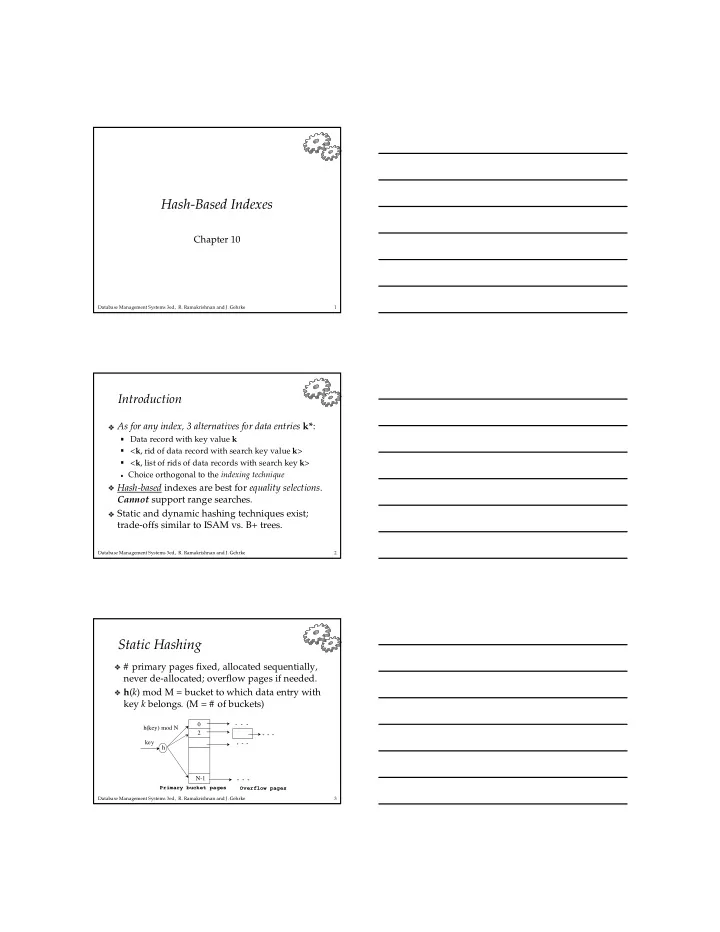

� ✁ � � � � ✂ ✁ ✁ Hash-Based�Indexes Chapter�10 Database�Management�Systems�3ed,��R.�Ramakrishnan�and�J.�Gehrke 1 Introduction As�for�any�index,�3�alternatives�for�data�entries� k* : Data�record�with�key�value k < k ,�rid�of�data�record�with�search�key�value k > < k ,�list�of�rids�of�data�records�with�search�key� k > Choice�orthogonal�to�the� indexing�technique Hash-based indexes�are�best�for� equality selections .� Cannot support�range�searches. Static�and�dynamic�hashing�techniques�exist;� trade-offs�similar�to�ISAM�vs.�B+�trees. Database�Management�Systems�3ed,��R.�Ramakrishnan�and�J.�Gehrke 2 Static�Hashing #�primary�pages�fixed,�allocated�sequentially,� never�de-allocated;�overflow�pages�if�needed. h ( k )�mod�M�=�bucket�to�which�data�entry�with key k� belongs .� (M�=�#�of�buckets) 0 h(key)�mod�N 2 key h N-1 Primary�bucket�pages Overflow�pages Database�Management�Systems�3ed,��R.�Ramakrishnan�and�J.�Gehrke 3
✁ ✄ ✄ ✄ � ✄ � ✄ ✄ ✁ ✂ ✄ ✄ ☎ � ☎ ✄ ✁ ☎ ✂ ✂ ✂ ✂ ✂ ✂ ✂ ✂ ✁ ✁ ✄ ✁ ✁ ✁ ✁ ✁ � ☎ ✂ ✆ � � ✂ ✂ � ✂ ✆ ☎ ✆ � ✆ ✆ ✂ ✂ ☎ ✂ ☎ ☎ ✆ ☎ ☎ ✆ ✆ ✂ ✂ Static�Hashing�(Contd.) Buckets�contain� data�entries . Hash�fn�works�on� search�key� field�of�record� r.�� Must� distribute�values�over�range�0�...�M-1. h ( key )�=�(a�*� key +�b)�usually�works�well. a�and�b�are�constants;��lots�known�about�how�to�tune� h . Long�overflow�chains�can�develop�and�degrade� performance.�� Extendible and� Linear Hashing :�Dynamic�techniques�to�fix� this�problem. Database�Management�Systems�3ed,��R.�Ramakrishnan�and�J.�Gehrke 4 Extendible�Hashing Situation:�Bucket�(primary�page)�becomes�full.� Why�not�re-organize�file�by� doubling� #�of�buckets? Reading�and�writing�all�pages�is�expensive! Idea :��Use� directory�of�pointers�to�buckets ,�double�#�of� buckets�by� doubling�the�directory,� splitting�just�the� bucket�that�overflowed! Directory�much�smaller�than�file,�so�doubling�it�is� much�cheaper.��Only�one�page�of�data�entries�is�split.�� No overflow page ! Trick�lies�in�how�hash�function�is�adjusted! Database�Management�Systems�3ed,��R.�Ramakrishnan�and�J.�Gehrke 5 LOCAL�DEPTH 2 Bucket�A 4* 12* 32* 16* GLOBAL�DEPTH Example 2 2 Bucket�B 00 1* 5* 21* 13* Directory�is�array�of�size�4. 01 To�find�bucket�for� r ,�take� 10 2 last�` global�depth ’�#�bits�of� Bucket�C 10* 11 h ( r );�we�denote� r by� h ( r ). If� h ( r )�=�5�=�binary�101,�� 2 DIRECTORY Bucket�D it�is�in�bucket�pointed�to� 15* 7* 19* by�01. DATA�PAGES Insert :��If�bucket�is�full,� split it�( allocate�new�page,�re-distribute ). If�necessary ,�double�the�directory.��(As�we�will�see,�splitting�a bucket�does�not�always�require�doubling;�we�can�tell�by� comparing� global�depth� with� local�depth� for�the�split�bucket.) Database�Management�Systems�3ed,��R.�Ramakrishnan�and�J.�Gehrke 6
✎ ✒ ☛ ☛ ☛ ☛ ☛ ✒ ✒ ✒ ☛ � ✒ ✒ ✂ ✒ ✒ ✂ ☛ ☛ ✒ ✠ ✟ ✠ ✠ ✠ ✠ ✠ ✠ ✠ ✡ ✡ ✡ ✡ ✡ ✎ ✡ ✡ ✒ � ✟ ✍ ✎ ✍ ✍ ✍ ✍ ✍ ✍ ✍ ✎ ✍ ✍ ✎ ✎ ✎ ✎ ✎ ✎ ✏ ✑ ✑ ✂ ✑ ✑ ✑ ✑ ✑ ✑ ✏ ✏ ☞ ☞ ☞ ☞ ☞ ✏ ✏ ✟ ✡ ✟ ✆ ☎ ☎ ☎ ☎ ☎ ✆ ✆ ✆ ☎ ✆ ✆ ✆ ✆ � � ✞ ✁ ☎ ☎ � ✂ ✁ ✁ ✁ ✂ ✂ ✂ ✂ ✂ ✄ ✂ ✂ ✂ ✂ ✄ ✄ ✄ ✄ � ✁ � ✝ ✞ ✞ ✞ ✝ ✝ ✝ ✝ Insert� h (r)=20�(Causes�Doubling) 2 LOCAL�DEPTH 3 LOCAL�DEPTH Bucket�A 32*16* 32* 16* GLOBAL�DEPTH Bucket�A GLOBAL�DEPTH 2 2 3 2 Bucket�B 00 1* 5* 21*13* 1* 5* 21*13* 000 Bucket�B 01 001 2 10 2 010 Bucket�C 11 10* 10* Bucket�C 011 100 2 2 DIRECTORY 101 Bucket�D 15* 7* 19* 15* 7* 19* 110 Bucket�D 111 2 3 Bucket�A2 4* 12* 20* DIRECTORY 4* 12* 20* Bucket�A2 (`split�image' of�Bucket�A) (`split�image' of�Bucket�A) Database�Management�Systems�3ed,��R.�Ramakrishnan�and�J.�Gehrke 7 Points�to�Note 20�=�binary�10100.��Last� 2 bits�(00)�tell�us� r� belongs�in� A�or�A2.��Last� 3 bits�needed�to�tell�which. Global�depth�of�directory :��Max�#�of��bits�needed�to�tell� which�bucket�an�entry�belongs�to. Local�depth�of�a�bucket :�#�of�bits�used�to�determine�if�an� entry�belongs�to�this�bucket. When�does�bucket�split�cause�directory�doubling? Before�insert,� local�depth� of�bucket�=� global�depth .��Insert� causes� local�depth� to�become�>� global�depth ;�directory�is� doubled�by� copying�it�over� and�`fixing’�pointer�to�split� image�page.��(Use�of�least�significant�bits�enables�efficient� doubling�via�copying�of�directory!) Database�Management�Systems�3ed,��R.�Ramakrishnan�and�J.�Gehrke 8 Directory�Doubling Why�use�least�significant�bits�in�directory? ✌ Allows�for�doubling�via�copying! 6�=�110 3 6�=�110 3 000 000 001 100 2 2 010 010 00 00 1 1 011 110 6* 0 01 0 10 100 001 6* 10 6* 01 1 101 1 101 6* 11 6* 11 6* 110 011 111 111 Least�Significant vs. Most�Significant Database�Management�Systems�3ed,��R.�Ramakrishnan�and�J.�Gehrke 9
✂ � ✂ � ✂ ✂ ✂ � ✂ ✂ � ✂ ✂ ✂ � � Comments�on�Extendible�Hashing If�directory�fits�in�memory,�equality�search� answered�with�one�disk�access;�else�two. 100MB�file,�100�bytes/rec,�4K�pages�contains�1,000,000� records�(as�data�entries)�and�25,000�directory�elements;� chances�are�high�that�directory�will�fit�in�memory. Directory�grows�in�spurts,�and,�if�the�distribution� of�hash� values� is�skewed,�directory�can�grow�large. Multiple�entries�with�same�hash�value�cause�problems! Delete :��If�removal�of�data�entry�makes�bucket� empty,�can�be�merged�with�`split�image’.��If�each� directory�element�points�to�same�bucket�as�its�split� image,�can�halve�directory.� Database�Management�Systems�3ed,��R.�Ramakrishnan�and�J.�Gehrke 10 Linear�Hashing This�is�another�dynamic�hashing�scheme,�an� alternative�to�Extendible�Hashing. LH�handles�the�problem�of�long�overflow�chains� without�using�a�directory,�and�handles�duplicates. Idea :��Use�a�family�of�hash�functions� h 0 ,� h 1 ,� h 2 ,�... h i ( key )�=� h ( key )�mod(2 i N);��N�=�initial�# �buckets h� is�some�hash�function�(range�is� not 0�to�N-1) If�N�=�2 d0 ,�for�some� d0 ,� h i consists�of�applying� h� and�looking� at�the�last� di bits,�where� di =� d0 +� i . h i+1� doubles�the�range�of� h i� (similar�to�directory�doubling) Database�Management�Systems�3ed,��R.�Ramakrishnan�and�J.�Gehrke 11 Linear�Hashing�(Contd.) Directory�avoided�in�LH�by�using�overflow� pages,�and�choosing�bucket�to�split�round-robin. Splitting�proceeds�in�`rounds’.��Round�ends�when�all� N R initial�(for�round� R )�buckets�are�split.��Buckets�0�to� Next-1� have�been�split;�� Next to� N R yet�to�be�split. Current�round�number�is� Level . Search: To�find�bucket�for�data�entry� r,� find h Level ( r ) : • If� h Level ( r )�in�range�` Next to� N R ’ ,� r� belongs�here. • Else,�r�could�belong�to�bucket� h Level ( r )�or�bucket� h Level ( r )�+� N R ;� must�apply� h Level +1 ( r )�to�find�out. Database�Management�Systems�3ed,��R.�Ramakrishnan�and�J.�Gehrke 12
Recommend
More recommend